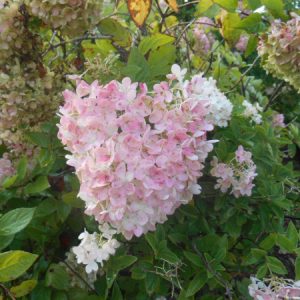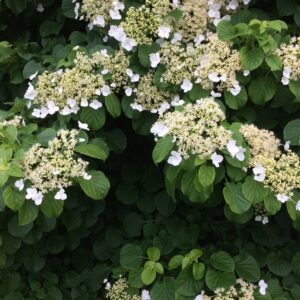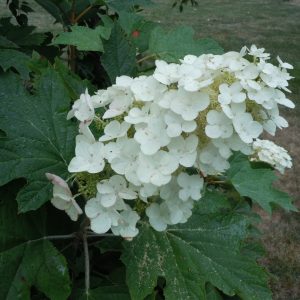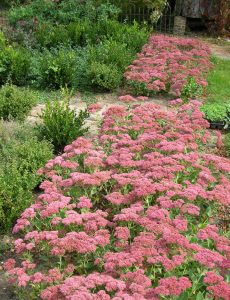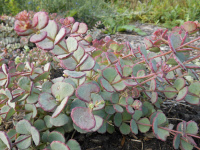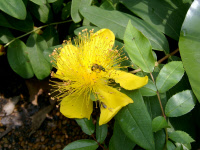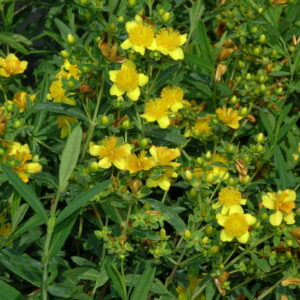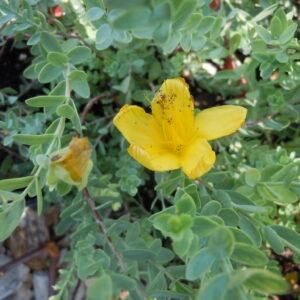Shop
Showing 409–416 of 785 results
-
Hydrangea paniculata ‘Grandiflora’ Pee-Gee hydrangea Z 4-8
In July and August, conical shaped heads, white fading to blush – spectacular.
ARCHIVED
Note: This is a plant not currently for sale. This is an archive page preserved for informational use.
In July and August, conical shaped heads, white fading to blush – spectacular.
Size: 4-5’ x 8’
Care: Moist to moist well-drained soil in full sun to part shade Prune: In late winter or early spring remove old inactive wood and last season's green growth. Cut back branches to control the height and spread of the shrub and create more dense growth. Cut old wood down to the crown of the plant and place all cuts on newer wood at the desired height, 1/4 inch above a leaf node or bud.
Native: Russia and Asia
Awards: Royal Horticultural Society Award of Merit.Hydrangea is Greek from hydor meaning water and aggeion meaning vessel referring to the cup shaped fruit. Von Siebold introduced H. paniculata from its native Japan in 1862. Five years later he introduced the variety ‘Grandiflora.’ The Wisconsin Horticultural Society recommended growing this in cemeteries and on lawns in 1896 – 1902.
-
Hydrangea petiolaris syn. Hydrangea anomala petiolaris Climbing hydrangea Z 4-8
Big white lacecap flowers blanket this climbing vine in early summer.
ARCHIVED
Note: This is a plant not currently for sale. This is an archive page preserved for informational use.
Big white lacecap flowers blanket this climbing vine in early summer.
Size: 40’ x 5-10’
Care: sun or shade in moist to moist well-drained soil
Native: Japan & Korea
Wildlife Value: Rich in nectar and pollen, its flowers attract bees, butterflies and more pollen-seeking insects.
Awards: Royal Horticultural Society Award of Garden MeritCollected by German physician and botanist Philipp Franz von Siebold in Japan during his residency on Nagaski working for the Dutch trading post there, 1823-1829. He introduced more than 2000 Japanese plants to Europe. 1st described in Flora Japonica 1839.
-
Hydrangea quercifolia Oakleaf hydrangea Z 5-9
Large blossoms, white turning pink and dark rose as the season advances. In fall the oak-shaped leaves become burgundy.
Large blossoms, white turning pink and dark rose as the season advances. In fall the oak-shaped leaves become burgundy.
Size: 4-5’ x 10’ slowly spreading by suckers.
Care: sun to part shade in moist well-drained soil. Protect the 1st few winters from rabbits eating young branches. It blooms on branches that overwintered so rabbit-eating or pruning after spring will prevent flowering.
Native: SE US
Wildlife Value: provides nectar and pollen to bees and butterflies and seeds to birdsCollected in central Georgia by William Bartram (1739-1823) c. 1775. Bartram, “most significant American nature writer before Thoreau,” traveled the wilderness of the SE, then colonies, now US, mostly alone, sometimes with his famous father, John Bartram. William wrote about and illustrated the flora, native Americans, animals, and insects. Grown at America’s 1st botanic garden, Elgin Botanic Garden 1811.
**LISTED AS OUT OF STOCK BECAUSE WE DO NOT SHIP THIS ITEM. IT IS AVAILABLE FOR PURCHASE AT OUR RETAIL LOCATION.
-
Hylotelephium herbstsfreude syn Sedum ‘Autumn Joy’ Z 4-9
Classic, large flat flower heads turn from green to rose
Classic, large flat flower heads turn from green to rose blooming in September and October. A staple for autumn in the garden.
Size: 30” x 12”
Care: full sun in well-drained soil
Wildlife Value: Attracts many bees and butterflies. Black walnut tolerant, deer resistant.
Awards: England’s Royal Horticultural Society Award of Garden Merit.Autumn Joy introduced to gardens before 1920 by the George Arends Nursery in Ronsdorf, Germany.
-
Hylotelephium sieboldii syn Sedum sieboldii, October Daphne Z 3-9
Fleshy gray-green foliage edged with pink encircles the prostrate stems, flowering strawberry pink in fall. Perfect for rock gardens, front of border, fairy gardens, roof gardens, troughs and groundcover or anyplace with drought.
Fleshy gray-green foliage edged with pink encircles the prostrate stems, flowering strawberry pink in fall. Perfect for rock gardens, front of border, fairy gardens, roof gardens, troughs and groundcover or anyplace with drought.
Size: 4" x 8"
Care: full sun in moderately fertile, well-drained soil.
Native: Japan
Wildlife Value: Drought tolerant and deer resistant.
Awards: Elisabeth Carey Miller Botanical Garden Great Plant PickSedum means “plant that sits.” “Live forever” is an ancient Greek name for sedums. The Roman Pliny claimed that sedum’s juice treated wounds. In the 1500’s English herbalist Gerard called sedums “very full of life,” referring to succulent’s quality of being very easy to grow. This species named for its discoverer, Dr. Philipp Franz von Siebold (1791-1866). Von Siebold, a German doctor, worked for the Dutch East India Company as its resident physician on Deshima Island, off the coast of Japan. He boldly became too knowledgeable about Japanese affairs and was imprisoned by the Japanese in 1826 and then banished in 1828. When he left he carried nearly 500 plants with him to Europe. William Robinson, father of the mixed perennial border, described Sedum sieboldii as beautiful. He advised gardeners to grow it “in strong loam and mortar rubble in fully exposed positions (and use it as) an excellent plant for vases in summer.”
-
Hypericum calycinum St. John’s Wort, Aaron’s beard, Rose of Sharon Z 5-9
Showy yellow saucers with prominent stamens
ARCHIVED
Note: This is a plant not currently for sale. This is an archive page preserved for informational use.
Showy yellow saucers with prominent stamens July – Sept, that part of the summer when the early flush of flowers has gone.
Size: 6-12” x indefinite - great groundcover
Care: sun to part shade in moist well-drained soil
Native: Bulgaria and Turkey
Awards: Missouri Botanical Garden Plant of Merit1st collected by George Wheeler on a trip to Constantinople, now Istanbul, in early 1700’s
-
Hypericum kalmianum Kalm’s St. Johns wort SHRUB Z 4-7
Eye-catching yellow saucers with a puff of showy prominent stamens in mid to late summer complimenting the glaucous blue leaves on this mounding, easy- to-grow, shrub.
Eye-catching yellow saucers with a puff of showy prominent stamens in mid to late summer complimenting the glaucous blue leaves on this mounding, easy- to-grow, shrub.
Size: 3-4’ x 3-4’
Care: sun to shade in well-drained to moist well-drained soil. Blooms on new growth so prune in late winter to early spring as far back as you wish.
Native: Quebec to WI, S. to IL, Wisconsin native.
Wildlife Value: attracts bees and butterflies
Awards: Great Plants for Great PlainsThe name Hypericum comes from Greek hyper, meaning above, and eikon, meaning icon or image. The yellow flowers of some species were placed above images to ward off evil spirits, and according to legend, Satan pierced the leaves in revenge. This species collected by and named for Peter Kalm (1716-1779), Swedish plant hunter, on his expedition in North America, 1747-1751. Offered for sale in Bartram Garden’s 1783 Broadside, America’s 1st plant catalog. David Douglas (Douglas fir guy) also collected this at Niagara Falls per British botanist William Jackson Hooker (1785-1865).
**LISTED AS OUT OF STOCK BECAUSE WE DO NOT SHIP THIS ITEM. IT IS AVAILABLE FOR PURCHASE AT OUR RETAIL LOCATION.
-
Hypericum polyphyllum ‘Grandiflorum’ Dwarf St.John’s wort Z 5-9
mounds smothered in golden sunbursts
ARCHIVED
Note: This is a plant not currently for sale. This is an archive page preserved for informational use.
Dwarf shrubby mounds smothered in golden sunbursts June – August. Drought tolerant. Perfect for rock, railroad and fairy gardens.
Size: 8” x 6”
Care: sun to part shade in well-drained soil. Cut back after blooming for repeat.
Native: south-east Europe to Asia MinorIn gardens by 1753. Wm. Robinson (1933 ed. English Flower Garden) considered this the best St. John’s Wort: “…one of the largest flowered kinds… It is known by its very glaucous foliage and erect single stems, with bright yellow flowers about 2” across. It forms handsome specimens that flower early, and its value as a choice border plant can scarcely be overrated.”

